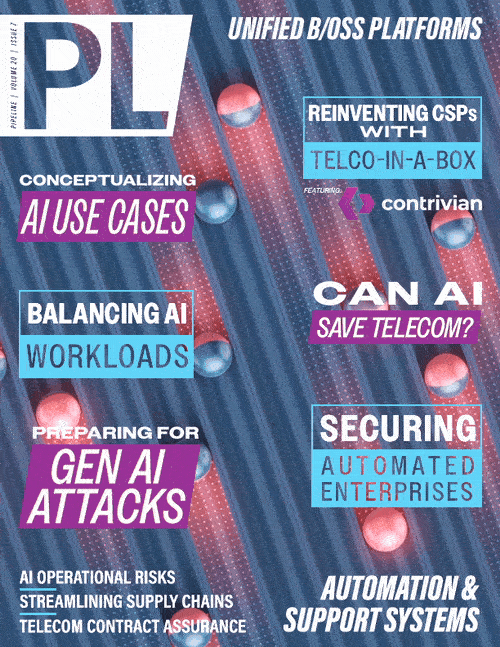Telco in a Box
Telco to Techco Transformation

By most accounts, telcos have been failing. Not fast enough to die, but just slow enough not to. And that’s quite a remarkable feat in the wake of the monumental shift to ecommerce and streaming services, an insatiable appetite for 4G/5G, a global pandemic that created a mandatory demand for global connectivity, and billions of connected devices coming online at the same time – when telcos own the pipes that make it all possible.
Despite the abundance of opportunities, the growth of connectivity services was stagnant from 2018 to 2021, and is only projected to grow at the modest rate of just 1 to 3 percent (Bain & Company/IDC, Omdia) through 2026, while Capital Expenses (capex) and layoffs (Omdia, IEEE) are projected to progress at the same time. One might wonder, are telcos trying to fail? No, we don’t think so, but that doesn’t mean they won’t.
Telco to Techco Transformation
In May 2021, Accenture and TM Forum published a report titled “The Tech-driven Telco,” which seems to have given rise to the term “telco to techco” transformation. Since that time, TM Forum has continued to push the concept forward with an iterative whitepaper and report in support of its Open Digital Architecture initiative. Today, it seems just about everyone has hopped onto the techco dance floor, including Oracle, who was later featured in Forbes with Vodafone in July of 2022 on the topic, followed by e& Group/Mckinsey & Company and Ericsson, Netcracker, and KPMG. Of course, it’s been well covered by Pipeline. In fact, it was still a persistent topic at Mobile World Congress this year. It’s as they say, necessity is the mother of invention.
To remain relevant, telcos must reinvent themselves. But when you peel back the onion layers of telcos stagnation, it reveals three obvious obstacles to transformation: culture, cost, and commoditization. From a cultural perspective, many telcos are mired in being a network-technology company if not an outright phone company (read, utility). To make matters worse, it’s really, really hard – and costly – to compete, as the next best network technology doesn’t come cheap. In the aforementioned report, Omdia cites network investments in 5G and fiber as key factors stifling global telco growth. At the same time connectivity, and the network itself, has become a commodity, and cost is the death note for commodity businesses (think oil, gold, copper, corn, etc.). The commodity business model isn’t necessarily bad business. But to succeed as a commodity business, telcos must fully embrace the commodity model and squarely focus on cost reduction and achieving greater efficiency through automation – such as artificial intelligence (AI) – to provide a better and unique customer experience (CX) that attracts and retains more customers. Or to make the shift to growth and innovation, they must abandon the commodity mindset altogether, and all three obstacles – culture, cost, and commoditization – must be overcome. But the first step to recovery is acceptance, and some telcos are still stuck in serious denial.
Rays of Hope
Some telecom service providers, on the other hand, are seizing the opportunity to transform and even reinvent the notion of what a telco is. Pipeline recently had the opportunity to meet with one, Contrivian. Contrivian is a new enterprise-focused Communications Service Provider (CSP) that provides access and connectivity services to multi-regional and multinational enterprises – including dedicated internet access, broadband, cloud connectivity, LTE, satellite, and more. We were also joined by two of its technology partners: Connectbase, an award-winning platform provider that is transforming how global network and connectivity services are bought and sold; and CloudSmartz, an award-winning unified experience platform provider that is consolidating the underlying Operational Support Systems and Business Support Systems (OSS, BSS, collectively B/OSS) technologies to streamline and automate network management and service fulfillment to provide a superior CX.
“Somewhat ironically, enterprises cannot buy enterprise-grade internet connectivity on the internet,” Founder and CEO of Contrivian, Grant Kirkwood, told Pipeline. “The traditional connectivity buying process takes months of conference calls, planning, quoting, and negotiating before you can even begin to think about design or delivery – when enterprises today need a choice of connectivity options delivered in near real time to keep up with modern use cases.” Today’s consumers are used to click-to-buy ecommerce experiences, yet largely telecom has failed to deliver this experience to its enterprise customers, who need it now more than ever.
Take, for example, the case of video conferencing companies such as RingCentral, Microsoft’s Skype or Teams, and Zoom. They all must provide the best quality connection and experience, at the lowest cost possible, and in real time. Or think about the healthcare industry, where a manufacturer of cloud-connected Computed Tomography (CT) or Magnetic Resonance Imaging (MRI) scanning equipment needs both fiber connectivity and cloud onramp for the transfer, processing, and analysis of dozens of gigabytes of image data, when lives are literally on the line. The legacy model simply doesn’t work.



















